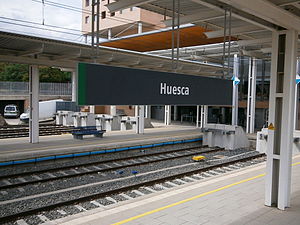
Transport in Spain is characterised by an extensive network of roads, railways, rapid transit, air routes, and ports. Its geographic location makes it an important link between Europe, Africa, and the Americas. Major forms of transit generally radiate from the capital, Madrid, located in the centre of the country, to link with the capitals of the autonomous communities.

Renfe, officially Renfe-Operadora, is the national passenger railway company of Spain.

Rail transport in Spain operates on four rail gauges and services are operated by a variety of private and public operators. The total route length in 2012 was 16,026 km.

Alta Velocidad Española (AVE) is a high-speed rail service in Spain operated by Renfe, the Spanish national railway company, currently at speeds of up to 300 km/h (186 mph), and formerly up to 310 km/h (193 mph).
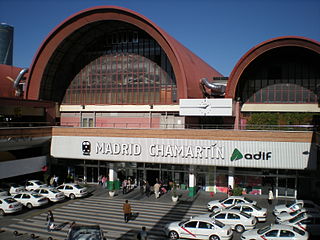
The Estación de Madrid-Chamartín Clara Campoamor or Madrid Chamartín is the second major railway station in Madrid, Spain. Located on the northern side of the city, it was built between 1970 and 1975, but more work was carried on into the early 1980s. It then superseded Atocha station, which is located just south of the city centre. However, as the AVE network expanded with a hub at Atocha, Chamartin again became Madrid's second station by passenger volume.

Canfranc is a municipality in the Aragón Valley of north-eastern Spain consisting of two villages, the original village and Canfranc Estación, which developed with the establishment of Canfranc International railway station to serve railway traffic across the Pyrenees.

Camp de Tarragona is a railway station, opened on 19 December 2006, on the Madrid-Barcelona high-speed rail line between Madrid and Barcelona. Located between the municipalities of La Secuita and Perafort, some 8 km north of Tarragona itself, the new station serves an area with an estimated population of over 400,000.

Barcelona Sants is the main railway station in Barcelona, owned by Adif, the railway infrastructure agency of Spain. It has become the most important transport hub of the city - being the centre of Rodalies de Catalunya including Barcelona suburban railway services and regional services, as well as the main inter-city station for national and international destinations. The station is named after Sants, the neighbourhood of Barcelona in which it is located. New parts of the station have recently been remodeled to accommodate the Spanish high-speed train AVE in the city, which started serving the city on 20 February 2008. There is also an adjacent international bus station bearing the same name, and a link to the Sants Estació metro station that serves the railway station.
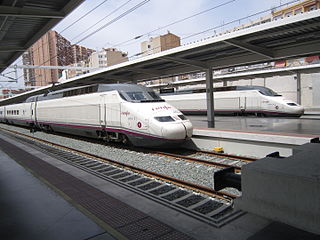
Alicante Terminal is the central railway station of Alicante, Spain. Commonly referred locally as the RENFE station, the station is part of Adif system, and is a terminal station.

Canfranc International railway station is a formerly international railway station in the village of Canfranc in the Spanish Pyrenees. The Somport railway tunnel, inoperative since 1970, which carries the Pau–Canfranc railway, under the Pyrenees into France, is located at its northern end.
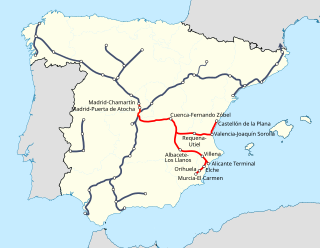
The Madrid–Levante high-speed network is a network of high-speed rail lines that connects Madrid with the Mediterranean coast of the Levante Region, specifically with Castilla-La Mancha, the Valencian Community and the Murcia Region autonomous communities.
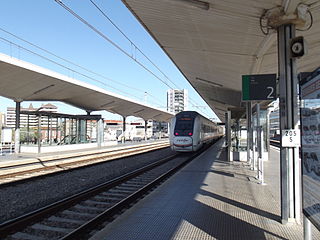
Girona is a railway station serving the city of Girona in Catalonia, Spain. It is located in the northern part of the municipality, lying at approximately 1 kilometre (0.62 mi) southwest of the city's historical centre.

Irun is a railway station in Irun, Basque Country, Spain. The station is located on the Bordeaux - Irun, Bilbao - Hendaye and Madrid–Hendaye railway lines. The station is served by TGV operated by the SNCF and Alvia, Talgo, Arco, Estrella and Cercanías San Sebastián services operated by RENFE.

The Pau–Canfranc railway is a partially-closed 93 km (58 mi) long international single-track standard gauge railway line connecting Pau in the Pyrénées-Atlantiques region of France, climbing via the Gave d'Aspe valley and tunneling under the Pyrenees, to Canfranc in Spain. The line is part of transport infrastructure between Bordeaux and Zaragoza and is now named the Goya Line, after the painter Francisco de Goya who was born near Zaragoza and died in Bordeaux.
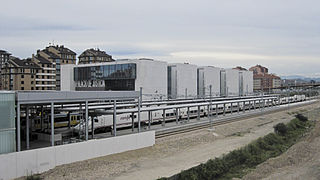
Gijón Railway Station, also known as Gijón Sanz Crespo, is the main railway station of Gijón, Spain. Since 2011 it is located in Sanz Crespo street due to the works for the Metrotrén Asturias project. It is the terminus for Alvia services from Madrid, Alicante, León, Valladolid and Barcelona, as well as Intercity and Media Distancia services from Madrid, Valladolid and León. It is also the last destination for four Cercanías commuter railway lines.

The Madrid–Galicia high-speed rail line is a high-speed railway line in Spain that links the city of Madrid with the region of Galicia via the cities of Olmedo, Zamora, Ourense and Santiago de Compostela. The line also connects the Atlantic Axis high-speed rail line to the rest of the Spanish AVE high-speed network. The Madrid–Galicia high-speed rail line is constructed as double electrified line and is designed for trains running at speeds up to 350 kilometres per hour (220 mph).
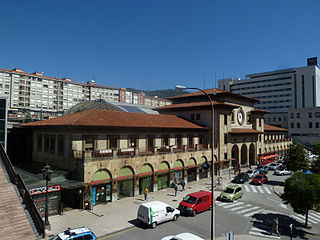
Oviedo railway station is the main station in the Spanish city of Oviedo, capital of the province of Asturias. It opened in 1874 and was reconstructed after the Spanish Civil War.

Antequera-Santa Ana railway station is a railway station serving the Spanish town of Antequera, Málaga in Andalusia. It is located 17 kilometres (11 mi) from the town centre, is served by the Spanish AVE high-speed rail system, on the Madrid–Málaga high-speed rail line. A gauge changer exists near the station, allowing trains to operate seamlessly on both standard gauge AVE tracks and Iberian gauge mainline tracks.

San Sebastián railway station, also known as Donostia-San Sebastián or Estación del Norte is the main railway station of the Spanish city of San Sebastián, Basque Country. It served over 2 million passengers in 2018.

Ciudad Real railway station is the main railway station of the Spanish city of Ciudad Real, Castilla–La Mancha. Located on the AVE high-speed rail line from Madrid Atocha to Seville-Santa Justa and Málaga María Zambrano, travel to Madrid can be achieved in under an hour.
